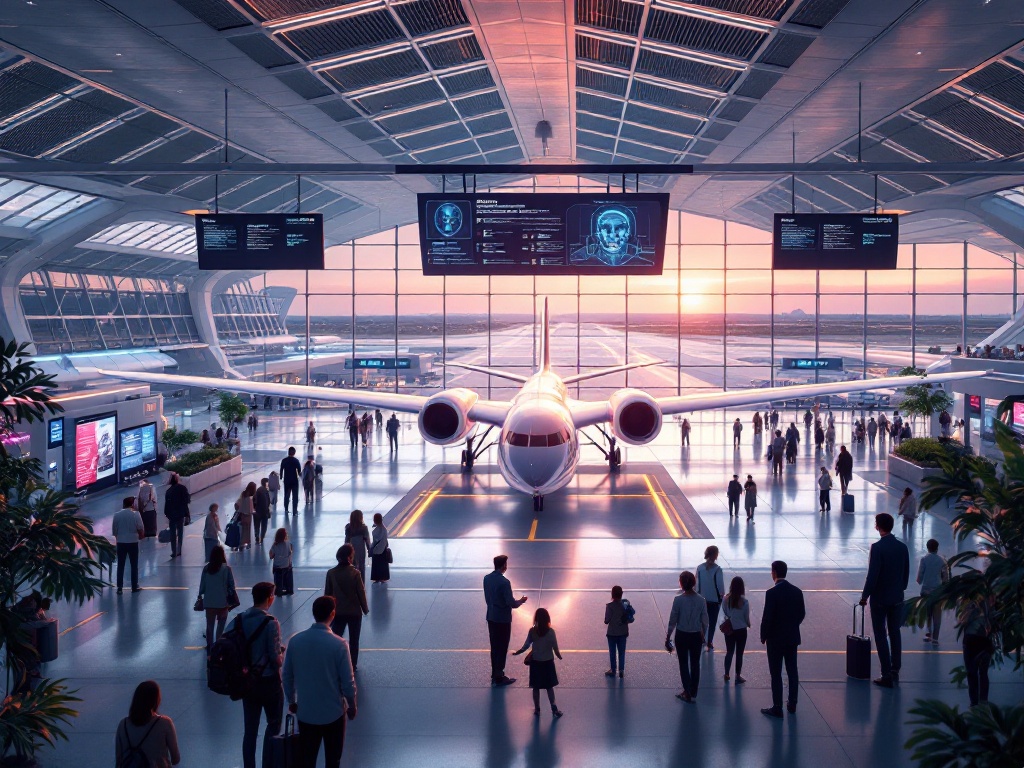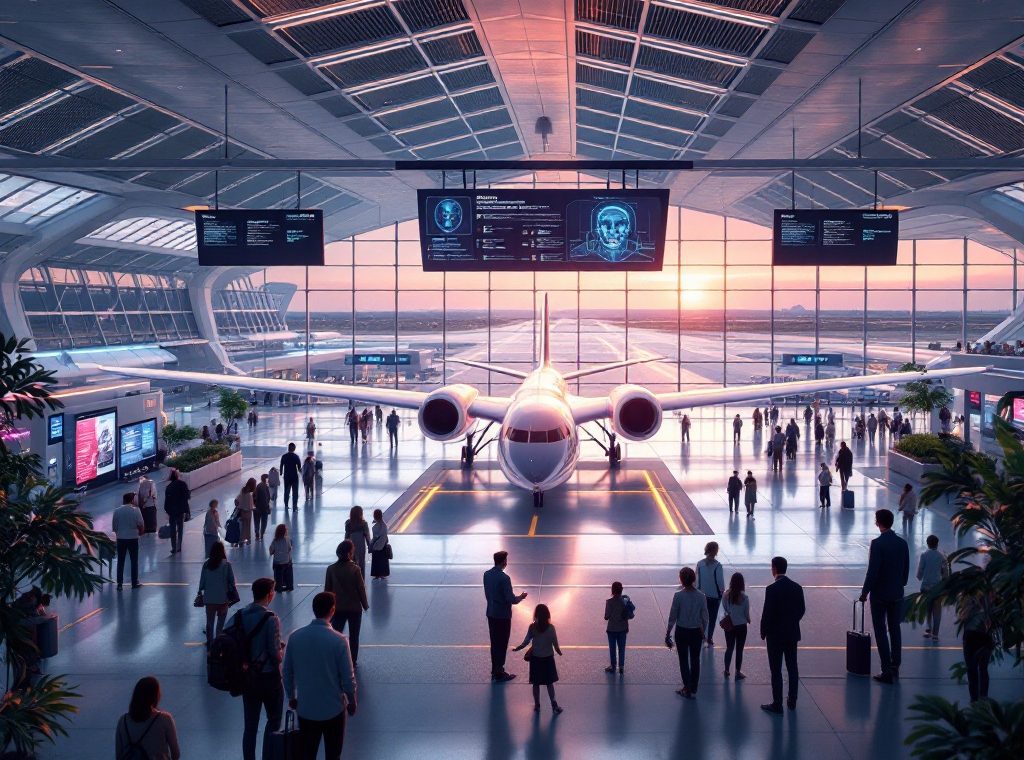Innovative Airport Business Solutions for 2025
Revolutionize your airport experience! Discover how AI, automation, and sustainable technologies are transforming aviation in 2025. Explore the rise of high-tech hubs, biometric security, and the exciting future of urban air mobility with eVTOL aircraft. Learn how these advancements optimize operations, enhance passenger journeys, and contribute to a greener future. Take off into the future of travel – read more now!
Important information

- Airports are becoming high-tech hubs, using AI, automation, and IoT to improve efficiency, sustainability, and passenger experience.
- Biometrics and touchless technologies are enhancing security and creating seamless travel experiences.
- Sustainable aviation fuels (SAFs) are gaining traction, offering significant reductions in carbon emissions.
- Urban air mobility, featuring air taxis and eVTOL aircraft, is set to revolutionize city travel.
- AI is optimizing various airport operations, from flight paths and maintenance to dynamic pricing and personalized services.
Innovative Airport Business Solutions for 2025: Transforming the Aviation Landscape
High-Tech Hubs
Airports are evolving into high-tech hubs focused on the passenger, emphasizing efficiency, sustainability, and personalized journeys.
Optimization and Flow
AI, automation, and the Internet of Things (IoT) are optimizing operations and improving passenger flow. Biometrics and touchless technologies enhance security and create seamless travel.
Sustainability Initiatives
Sustainability is a key focus, with green technologies and sustainable aviation fuels gaining traction.
Future of Aviation
The future of aviation is set to be revolutionary, featuring urban air mobility and advanced air mobility solutions.
Enhanced Passenger Experience
The integration of air taxis and eVTOL aircraft promises efficient and sustainable airports, ultimately enhancing the passenger experience.
Aviation Technology Trends for 2025
The aviation industry is undergoing a digital transformation. Airports are using AI and data analytics to optimize infrastructure and increase efficiency. A key change involves modernizing outdated systems, especially with the rise of biometrics and enhanced security. Sustainable aviation technologies are also a priority, along with improved in-flight connectivity. These advancements aim to enhance both efficiency and the passenger experience, while contributing to environmental sustainability.
Key Advancements in Aviation
- Robotics and automation will streamline processes like baggage handling and maintenance.
- The Internet of Things (IoT) is transforming operations.
- Private wireless networks will revolutionize data management and responsiveness.
Focus on Sustainability
- Sustainability efforts focus on reducing carbon emissions.
- Exploring innovative fuel solutions.
- Developing electric aircraft.
Immersive technologies are enhancing training programs and passenger engagement.
Transition to Modern Solutions
Airlines are rapidly modernizing, adopting cloud computing as a core technology by 2025. This transition strengthens operational resilience and elevates customer service. Digital twins and predictive maintenance are becoming increasingly common, while advanced materials are revolutionizing aircraft design. These advancements offer numerous benefits, including increased efficiency, improved scalability, and enhanced usability.
Advancements in In-Flight Connectivity
Airlines are enhancing the in-flight experience by incorporating satellite-based Wi-Fi, allowing passengers to stream movies and stay connected during their journey. This significant upgrade in connectivity transforms the travel experience, making it more enjoyable and productive. Airlines are also utilizing data analysis to personalize the entertainment options available to passengers. By analyzing passenger preferences, airlines can suggest movies and shows tailored to individual tastes, further enhancing the in-flight entertainment experience.
Collaborative Innovation in the Aviation Value Chain
Collaboration is essential for a thriving aviation industry, fueling efficiency and shaping modern travel hubs. Airports are increasingly focused on sustainability, sharing real-time data with airlines and cargo handlers to streamline processes and reduce passenger wait times.
Driven by collaborative efforts, airports are evolving into “aerocities,” optimizing resources and creating seamless travel experiences. Innovation programs prioritize key areas like baggage handling and passenger experience.
Aerospace research also relies on collaboration to address safety and sustainability, fostering innovation and minimizing the industry’s environmental impact. These modern travel hubs prioritize passenger satisfaction and boost non-aeronautical revenue through collaborative strategies and world-class data management.
Smooth airport operations depend on strong partnerships. Modernization requires a shift to cloud-based systems for better scalability and ease of use, ultimately improving customer service and operational resilience.
Airports as Modern Travel Hubs
Airports are transforming into advanced travel hubs, using technology like AI and data analytics to improve the passenger experience. Imagine a smooth “ready-to-fly” process, driven by AI for the best outcomes. High-speed networks and IoT devices are essential for efficient resource management and providing real-time passenger updates. Interactive digital displays guide travelers with helpful information, enhancing their overall airport journey. This makes travel smoother and more enjoyable.
Partnerships for Operational Efficiency
Airport partnerships are driving widespread efficiency gains. For instance, collaborative efforts to implement automation and robotics are enhancing reliability and streamlining various airport processes, such as baggage handling, quicker aircraft turnarounds, and smoother passenger flow.
Artificial Intelligence in the Aviation Industry
AI is revolutionizing airport operations, optimizing everything from flight paths and air traffic control to aircraft maintenance. This data-driven approach saves fuel, reduces emissions, and strengthens overall resilience. AI also enhances the passenger experience through dynamic pricing and personalized services.
AI-Powered Transformation
This transformation streamlines numerous processes. AI-powered chatbots provide constant customer support, anticipating passenger needs and resolving issues promptly. Machine learning anticipates maintenance needs, preventing costly equipment failures and ensuring smooth operations.
Benefits for the Aviation Industry
Optimized flight routes maximize fuel efficiency and contribute to a smaller carbon footprint. This fosters both sustainability and long-term competitiveness within the aviation industry, aligning with global environmental goals and enhancing operational efficiency.
AI for Optimisation and Efficiency
Artificial intelligence is transforming airports, using real-time data analysis to improve efficiency and enhance the passenger experience. AI predicts passenger flow, which leads to effective resource management and streamlines processes like check-in and security. Beyond the terminal, AI optimizes flight paths and air traffic control, while also predicting maintenance needs to prevent costly delays. AI-powered dynamic pricing benefits both airlines and passengers, and personalized services further improve customer satisfaction. Here’s how AI is making a difference:
Within the Terminal
AI anticipates passenger flow, allowing for better allocation of staff and resources at check-in and security checkpoints. This reduces wait times and improves overall passenger flow.
Beyond the Terminal
AI optimizes flight paths and air traffic control, minimizing delays and improving fuel efficiency. It also predicts maintenance needs, preventing potential disruptions and saving airlines money.
Pricing and Personalization
AI-powered dynamic pricing adjusts ticket costs based on demand, benefiting both airlines and travelers. Passengers can find better deals, and airlines can optimize revenue.
Enhanced Customer Satisfaction
Personalized services driven by AI enhance the overall travel experience. From customized recommendations to tailored assistance, passengers enjoy a more seamless and enjoyable journey.
Reshaping Aviation Dynamics with AI
Artificial intelligence is transforming aviation, enhancing safety and optimizing resources for significant improvements. Data automation plays a crucial role, connecting operational systems and providing real-time access to information. This allows airlines to react quickly to changes while also improving the passenger experience. Furthermore, AI-powered personal assistants are changing travel by enabling convenient flight bookings and providing valuable travel information. This shift requires airlines to adapt and offer intuitive booking processes to meet consumer demand. Here’s how AI is making a difference:
Enhanced Safety
AI improves safety by analyzing vast amounts of data to predict and mitigate potential risks.
Optimized Resources
AI optimizes resource allocation, leading to fuel efficiency and cost reduction for airlines.
Improved Passenger Experience
Real-time data access enables airlines to respond effectively to disruptions, minimizing passenger inconvenience.
Convenient Booking and Travel Information
AI-powered personal assistants simplify travel planning, providing easy booking options and valuable travel information.
Embracing Robotics and Automation in Airports
Airports are evolving, leveraging automation and robotics to boost efficiency and streamline operations. From baggage handling and maintenance to passenger services, these technologies are minimizing errors and enhancing the traveler experience.
Automation and robotics are key to this transformation, streamlining tasks like baggage handling, check-in, and even security screenings. By accelerating these processes and reducing human error, airports can ensure smoother operations and greater passenger satisfaction.
Furthermore, autonomous vehicles play a vital role in optimizing workflows. By transporting luggage and supplies, these vehicles decrease manual labor while increasing speed and efficiency, ultimately contributing to a smoother, more satisfying passenger experience. This not only improves efficiency but also allows staff to focus on more complex tasks, ultimately enhancing the overall passenger experience.
Implementing Automation and Robotics
Robotics and automation are transforming airports, streamlining operations for smoother workflows. Automated baggage handling, robotic assistants, and self-driving vehicles boost efficiency and reliability.
- Automated baggage handling ensures efficient and reliable luggage processing.
- Robotic assistants enhance operational efficiency.
- Self-driving vehicles improve overall airport workflows.
Passenger services are also seeing improvements. Automated systems reduce errors, minimizing lost luggage. Robotic assistants provide quick, accurate information, while autonomous vehicles efficiently transport passengers within the airport, creating a smoother, more enjoyable travel experience.
- Automated systems enhance accuracy and reduce lost luggage incidents.
- Robotic assistants offer quick and precise information to passengers.
- Autonomous vehicles ensure efficient passenger transport within the airport.
Autonomous Vehicles for Efficient Workflows
Self-driving vehicles are revolutionizing airport operations, boosting efficiency in several key areas. These vehicles offer significant advantages for airports, handling baggage, towing aircraft, and even inspecting runways, which reduces human error and improves turnaround times. Furthermore, they efficiently transport goods and personnel across the airfield.
Internet of Things and Wireless Networks in Airports
High-speed wireless networks are essential for modern airports, enabling real-time data transmission and processing to support various IoT devices. This integration facilitates efficient resource management, optimizes operations, and enhances the passenger experience. Real-time updates boost customer satisfaction by streamlining airport functions and providing valuable insights into passenger journeys and overall operations.
Benefits of Integrating IoT and Wireless Networks in Airports
Integrating IoT and wireless networks offers several key advantages:
- Improved passenger flow, reducing congestion and wait times.
- Enhanced operational efficiency through optimized resource management and streamlined processes.
- Elevated passenger experience with smoother transitions and real-time information access.
How Real-Time Data Analysis Optimizes Airport Operations
Real-time data analysis plays a crucial role in optimizing airport functions:
- Predictive passenger movement analysis enables efficient gate assignments and reduces congestion.
- Real-time insights into operations empower informed decision-making and proactive adjustments.
- Valuable data for passenger journeys provides personalized information and improves travel experience.
Enhancing Connectivity and Data Processing
Enhanced connectivity drives faster data processing, improving various airport operations. This includes more efficient management of passengers, baggage, and aircraft. Robust networks further boost data processing speeds, optimizing resource allocation and enabling smarter decision-making.
Improving Passenger Flow and Congestion
Predictive analytics anticipates peak airport times, improving resource allocation and minimizing congestion with real-time updates.
Faster check-in and security lines smooth passenger flow, enhancing the travel experience.
AI and data analytics optimize existing infrastructure, reducing the need for expensive construction projects.
Smart queue management and biometric systems further boost passenger satisfaction and create new revenue opportunities.
Ultimately, predictive analytics is a powerful tool for improving air travel.
Biometric Solutions and Digital Identity at Airports
Biometric technology is revolutionizing the airport experience. It uses facial recognition and fingerprint scans to enhance security by rapidly verifying passenger identities. Touchless kiosks and automated gates minimize contact, improving hygiene and expediting passenger flow. These advancements streamline the entire process, reducing wait times and increasing efficiency. Secure digital platforms for passenger data further smooth transitions between checkpoints, creating a safer and more personalized experience.
How Biometrics Works
Biometric screening utilizes unique biological traits like facial features, iris patterns, and fingerprints. This technology offers a secure and efficient way to verify passenger identities.
Benefits of Touchless Technology
Touchless technology, such as self-check-in kiosks and automated gates, limits physical contact and optimizes airport operations. This improves the passenger experience, decreases wait times, strengthens security, and reduces contamination risks.
Enhanced Security and Personalization
Biometric solutions and digital IDs enhance security by protecting sensitive information and preventing fraud. Personalized services, tailored to individual travel histories and preferences, further elevate passenger satisfaction.
Data Privacy Considerations
Careful consideration of data privacy and security is paramount when implementing these technologies. This ensures responsible and ethical use of passenger information.
Biometric Screening and Touchless Technology
Biometric screening, such as facial recognition and fingerprint scanning, expedites airport processing. This touchless technology minimizes contact, improving hygiene and passenger flow. These advancements enhance security while creating a more efficient and safer travel experience.
Secure and Personalized Passenger Experiences
Biometric technology, like facial recognition, is revolutionizing air travel, enhancing security while expediting the entire process. Imagine a personalized airport experience, tailored to your individual data, offering customized services such as expedited security for frequent flyers.
Benefits of Biometric Technology
Biometrics streamlines numerous processes, from quicker check-in and simplified baggage drop-off to faster security checks. This significantly reduces wait times, improves passenger flow, and ultimately creates a smoother, less stressful travel experience.
Challenges of Biometric Technology
Privacy concerns remain a critical challenge, demanding robust data protection measures.
Sustainability Initiatives in Aviation for 2025
Airports are investing in technologies to minimize their environmental impact. These include solar power, sustainable aviation fuel (SAF) plants, and water recycling systems. They are also shifting towards electric and hybrid aircraft and exploring hydrogen fuel to reduce greenhouse gas emissions.
Green Initiatives at Airports
- installing solar panels and electric vehicle chargers,
- using energy-efficient lighting,
- reducing reliance on fossil fuels and lowering carbon emissions.
Sustainable Aviation Fuels (SAFs)
SAFs offer up to an 80% reduction in carbon emissions compared to conventional jet fuel. Airport investments in SAF production and supporting infrastructure will encourage broader adoption of this vital technology.
Airports Investing in Green Technologies
Airports are investing in greener technologies to lessen their environmental impact. These include solar power, sustainable aviation fuels, and innovative water recycling systems. Such initiatives reduce carbon footprints and promote sustainability within the aviation industry. For example, solar panels are being installed on terminal roofs, and the use of electric vehicles is increasing on the ground. These efforts contribute to a more sustainable future for air travel.
Sustainable Aviation Fuels
Sustainable aviation fuels (SAFs) are gaining traction as airlines adopt them to reduce their environmental impact. These fuels offer substantial carbon emission reductions compared to conventional jet fuel, a significant environmental benefit. Airports are also incorporating SAFs into their sustainability initiatives, aiming to lower greenhouse gas emissions. The aviation industry’s broader shift towards eco-friendly practices further supports this progress. However, challenges persist, including the need to scale up SAF production and lower costs. Despite these obstacles, SAFs remain a key element in achieving cleaner air travel.
Benefits of SAFs
- substantial carbon emission reductions,
- a key element in achieving cleaner air travel.
Challenges of SAFs
- the need to scale up SAF production,
- lower costs.
Urban and Advanced Air Mobility Concepts
Air taxis promise to transform city travel, offering on-demand flights using vertical takeoff and landing (VTOL) aircraft. This VTOL capability allows access to far more locations than conventional airplanes, potentially slashing travel times and boosting accessibility. Electric VTOL (eVTOL) aircraft are crucial for this urban air mobility revolution.
Infrastructure and Integration
Successful integration with existing transport networks hinges on developing new infrastructure, like vertiports for takeoff and landing. Streamlined booking systems must connect seamlessly with other transportation choices.
Example
Uber Elevate exemplifies this integration, partnering with cities to build skyports—a major stride toward seamless urban air travel.
Future of Air Taxi Services
Air taxis promise to revolutionize urban travel, offering a convenient aerial alternative and fostering greater connectivity within cities. They aim to reduce traffic congestion and commute times significantly. Air taxis also offer a more sustainable mode of transportation compared to traditional vehicles, contributing to a greener urban environment. Furthermore, they provide enhanced accessibility to remote or underserved areas, bridging transportation gaps and promoting economic development. These advancements hold the potential to reshape urban mobility as we know it.
Integrating eVTOL and Mobility Solutions
eVTOLs seamlessly integrate with existing public transport, creating a smooth, interconnected travel experience. This solves the first-mile/last-mile problem, reducing reliance on personal vehicles. Imagine booking platforms that manage every leg of your journey, facilitating streamlined transfers for enhanced accessibility and convenience. This makes travel significantly easier for everyone.


















